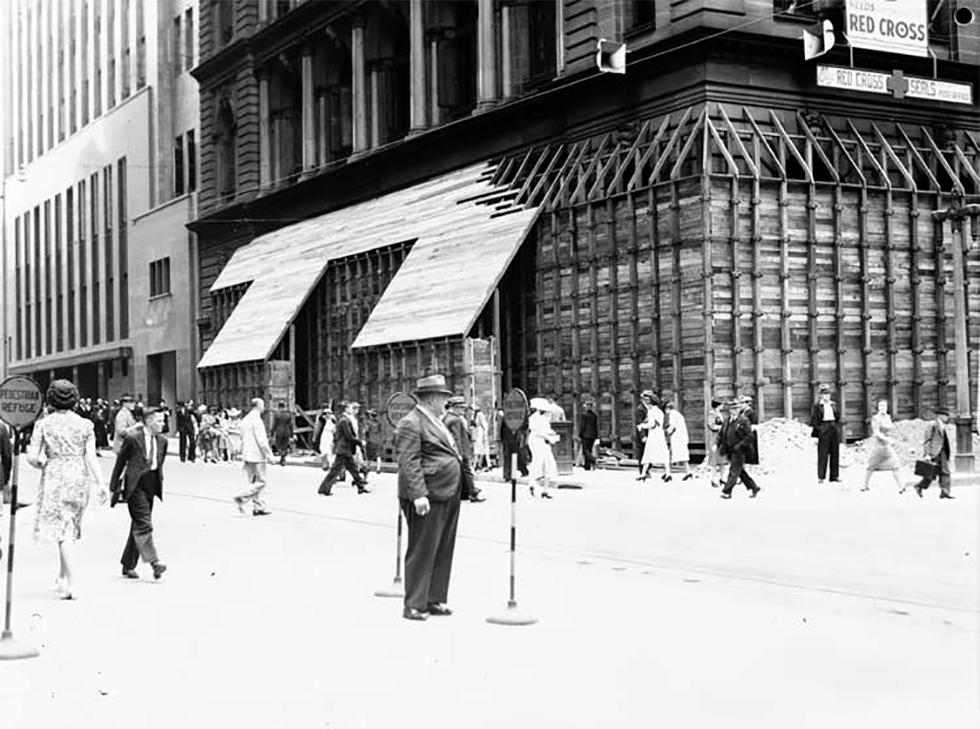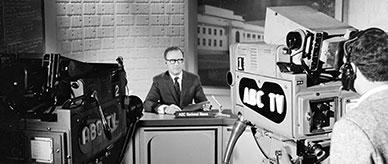


About this record
This is a black-and-white photograph showing the air raid protection erected around the old Sydney General Post Office on the corner of Pitt Street and Martin Place. The new post office building is also visible, as are Red Cross posters and signs for a pedestrian refuge (air raid shelter). People can be seen standing and walking in the streets.
Educational value
- Illustrates the seriousness with which Sydney took the threat of an air attack by the Japanese – the early campaigns of the Second World War were fought far away from Australia in the northern hemisphere, but in 1942 the war was brought home to Australians when Horn Island in the Torres Strait was targeted for its airstrip, Mossman in far north Queensland was raided, Darwin and Townsville were bombed, and the Japanese attacked Sydney Harbour from the sea, entering the harbour in miniature submarines.
- Shows loud speakers mounted on the buildings to broadcast air raid warning sirens – by February 1942, many Australians thought that the Japanese would invade Australia and the bombing of cities along the coastline was expected; a secret War Cabinet document of the time indicated that the Australian military forces would have been unable to defend the coastline from invasion.
- Depicts the old GPO building substantially altered to become a pedestrian refuge (air raid shelter) – a framework covered with timber slats is shown under construction over the existing thick stonework of the building with wide sloping awnings to protect pedestrians as they entered; in the same year, the building's clock tower was dismantled as an Air Raid Precaution (ARP).
- Illustrates signs for the pedestrian refuge about to be put in place – although many people erected Anderson shelters in their backyards, they needed protection from air raids when they were away from home and tunnels and shelters were set up around Sydney; the signs showed the way.
- Shows two types of Air Raid Precautions (sirens and a refuge) – many other measures were also introduced: blackout restrictions were enforced by ARP wardens; windows were covered with brown paper and netting; children at school were issued with identity tags in case they had to be evacuated to somewhere safer; shelters were dug; volunteers were trained in first aid, firefighting and other air raid precautions; buses were camouflaged with brown, black and green paint and fitted with metal windows; and a series of air raid precaution instructions with photographs was published in the newspapers.
- Shows one of Sydney's most famous intersections without any street signage – the removal of street signs was one of the preparations made for invasion; barbed wire strung across many east coast beaches was another.
- Shows posters for the Red Cross on the side of the building – voluntary organisations such as the Red Cross played an important role in World War II, working in hospitals throughout Australia, cooking meals, carrying out immunisation programs and organising blood donor drives.
- Shows the new Post Office building, its sleek modern lines in stark contrast with the splendour of the old building which was famous for the richness of its carvings.
Acknowledgments
Learning resource text © Education Services Australia Limited and the National Archives of Australia 2010.
Related themes
Need help with your research?
Learn how to interpret primary sources, use our collection and more.


